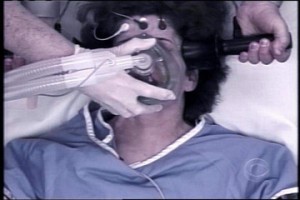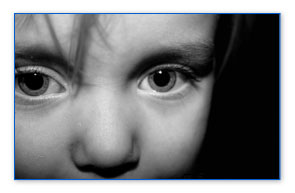YET ANOTHER BOGUS ELECTROSHOCK STUDY
by CCHR International—March 20, 2012

electroshock (renamed electroconvulsive 'treatment') delivers up to 460 volts of electricity through the brain
A new Scottish study hailing the wonders of electroshock treatment has provided yet another lame theory about how this violent therapy might “work.” And while the press seem content to robotically reiterate this bogus study, we’d like to point out the actual facts.
Professor Ian Reid from the University of Aberdeen, and colleagues claim that ECT works by “turning down” an overactive connection between areas of the brain causing depression. Incredibly, the authors claim electric shock may restore the brain’s natural chemical balance. This logic is so moronic we’re not sure where to start. First consider the fact that there is no proof that mental distress is due to a “chemical imbalance.” That theory was an invention of the psychiatric/pharmaceutical industry and has never been proven. In fact, “leading” psychiatrists on National Public Radio recently admitted that the “chemical imbalance in the brain” theory is a fraud, and that pharmaceutical companies and psychiatrists invented it to market Prozac.[1] Another study that revealed that for 13 years media reported psychiatrists’ “discoveries” of a genetic/neurological cause of mental problems, none of which was subsequently proven.[2]
The Aberdeen findings are just more of the same hype: “emerging” theory, “may” constitute a biological marker, they’ve
found a “potential” therapeutic target in the brain. And the all-telling: “It is tempting to speculate that ECT might act to rebalance” specific brain activity “but the data presented here cannot confirm or refute this notion.” [Emphasis added][3] Let’s look more closely at what doesn’t get reported in the media:
- The sample size in the study—9 people—is so small that it’s worthless. The study admits: “the sample size is small.”
- The patients had to have had a history of failing to “respond to psychotropic medication” yet were kept on drugs during the study. Four patients were taking antipsychotic drugs, which are known to cause brain shrinkage.
- The researchers admit: “medication effects cannot be ruled out.” In other words, any so-called visible change seen through an MRI could be drug-induced.
- As “depression” cannot be seen through or diagnosed by any brain scan or MRI, there’s no telling what the MRI used in the study was reacting to.
- The ECT device was a Thymatron, made by the U.S. company called Somatics. [4] The company is currently embroiled in controversy because in over 30 years, it has never submitted a “Pre-Marketing Application” to the Food and Drug Administration (FDA) which is required to show the device is “safe and effective” before it can be approved for use. Recent testimony to the FDA said the device causes brain damage in patients.
- Neurologists state that the damage caused by the electricity sent through the brain during ECT is equivalent to that seen in head trauma. Dr. John Friedberg says ECT causes more permanent memory loss than any severe closed-head injury with coma.[5]
Reid is the Chair of “The ECT and Related Treatments Committee” for Royal British College of Psychiatrists and is a long-term proponent of biological interventions for people with mental problems, including antidepressants. He is opposed to any ban on “compulsory” ECT. [6] Therefore, it is in his interests to devise a theory to justify enforcing the violence of electroshock on someone against their will.
“These bastards are trying to kill me.”
Yet, patients undergoing electroshock testify it is “cruel and unusual treatment” in violation of Article 5 of the UN Universal Declaration of Human Rights.
Evidence such as these patients who were given ECT and testified before an Australian government inquiry:
- “I have memories of shock treatment being administered…it was like someone trying to twist my head…I remember screaming out at one stage about the cruelty I was receiving….”
- “…it felt like all the telegraph wires came down on the top of my head and a big blue flash all around me.”
- “The feeling was one of pain from the top of your head to the tip of your toes…It was like someone hit you with a sledgehammer, wham, and you exploded. It was so bad that [I] thought, ‘These bastards are trying to kill me.’”
Reid’s claims about a biological marker for depression that can be corrected by electroshock is about as scientific and as irresponsible as a neurosurgeon performing surgery on a non-existent brain tumor.
The study is self-serving. As a British Journal of Psychiatry editorial admitted, ECT serves only to stimulate “biological psychiatry” and powerfully reinforces the belief in somatic (physical) treatments in psychiatry. [7]
[1] Jonathan Leo Ph.D. and Jeffrey Lacasse, Ph.D., “Psychiatry’s Grand Confession,” MadinAmerica.com, 23 Jan 2012
[2] Sarah Colyer, “Media over-optimistic about gene discoveries in psychiatry,”
Psychiatry Update (Magazine from publishers of Australian Doctor) 6 Oct. 2011; http://www.psychiatryupdate.com.au/getattachment/b73012c5-11de-4af7-b56d-e82430aa995d/pdf.aspx
[3] http://www.pnas.org/content/early/2012/03/12/1117206109.full.pdf+html?sid=6b7f2f97-0645-46fe-b44c-a419df537dac
[4] http://www.pnas.org/content/early/2012/03/12/1117206109.full.pdf+html?sid=6b7f2f97-0645-46fe-b44c-a419df537dac
[5] http://www.ect.org/effects/headinjury.html
[6] Psychological Medicine (1999), 29 : pp 221-223, http://journals.cambridge.org/action/displayAbstract;jsessionid=FB7CAB8737E83B61E5DE55F3768E0CF5.journals?fromPage=online&aid=25899 1999 Cambridge University Press
[7] JOHN READ and RICHARD BENTALL, “The effectiveness of electroconvulsive therapy: A literature review,” Epidemiologia e Psichiatria Sociale, 19, 4, 2010


